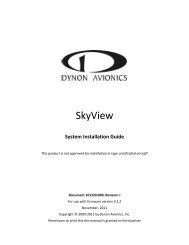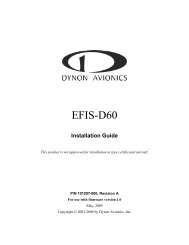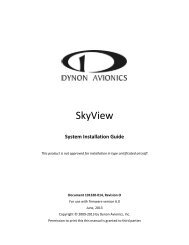EFIS-D100 Installation Guide - Dynon Avionics
EFIS-D100 Installation Guide - Dynon Avionics
EFIS-D100 Installation Guide - Dynon Avionics
You also want an ePaper? Increase the reach of your titles
YUMPU automatically turns print PDFs into web optimized ePapers that Google loves.
4. <strong>EFIS</strong> CALIBRATION AND CONFIGURATION<br />
During manufacture, your <strong>EFIS</strong>-<strong>D100</strong> underwent a comprehensive calibration, verification, and<br />
burn-in routine that minimizes setup time and ensures that your <strong>EFIS</strong> meets <strong>Dynon</strong>’s stringent<br />
performance specifications. To account for your individual preferences and your aircraft’s<br />
particular setup, there are a few simple calibration and configuration steps that you must<br />
complete before using your <strong>EFIS</strong>-<strong>D100</strong>. This section takes you through these steps to make sure<br />
that you have properly installed and configured your <strong>EFIS</strong>-<strong>D100</strong>.<br />
CAUTION: It is your responsibility to fly your plane safely while performing any<br />
configuration or calibration in flight. The best scenario would include a second person to<br />
perform any necessary steps on the unit.<br />
Ensuring Proper <strong>Installation</strong><br />
Turn your unit on by energizing the aircraft power to which it is connected. Ensure that the<br />
screen is bright and readable and that all instrument displays appear. If a desired display item is<br />
not present, refer to the User’s <strong>Guide</strong> to use the CLUTTR feature to display the missing item.<br />
Setting Zero Pitch (In flight)<br />
For the purposes of this setting, level is defined as the attitude at which the aircraft’s<br />
longitudinal axis is parallel to the ground. For most aircraft, the attitude the aircraft<br />
assumes at normal cruise speeds will be acceptable. Additionally, this feature should not<br />
be used to “zero out” pitch when the aircraft is at an attitude other than level. Do not<br />
think of this adjustment as you would the parallax adjustment on a normal attitude<br />
indicator. Instead, think of it as a calibration step which is not changed often.<br />
With your aircraft flying straight and level, enter the <strong>EFIS</strong> > SETUP > PITCH menu. Press INC<br />
or DEC until the horizon line intersects the center of the crosshairs. It is important that this be<br />
done while the aircraft is level to ensure proper pitch and roll display throughout all maneuvers.<br />
Compass Heading Calibration<br />
This section guides you through the calibration and configuration of your magnetic heading<br />
indication. Prior to calibrating your EDC-D10A, you must configure the local magnetic<br />
inclination and magnetic intensity as described in the sections below.<br />
In a DSAB network, the Bus Master’s heading is used as the only heading source for all<br />
connected instruments. However, in the event of a DSAB failure, <strong>EFIS</strong> instruments revert<br />
to their local heading source. In a system already using a shared heading, you may still<br />
configure and calibrate the local heading source. As soon as you bring up any of the<br />
magnetic calibration menus (MAGINC, MAGCAL, MAGADJ, MAGINT), the heading<br />
and DG displays switch to display the locally-derived heading indication. The display<br />
stays on that source until exiting the magnetic configuration menu. If you do not have an<br />
EDC-D10A connected, REMOTE COMPASS NOT DETECTED is displayed when in<br />
any of these menus.<br />
<strong>EFIS</strong>-<strong>D100</strong> <strong>Installation</strong> <strong>Guide</strong> 4-1
















